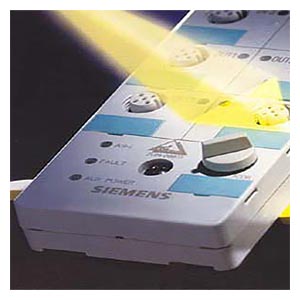ENG_669466.XML
Scope of AS-Interface specification V3.0
|
Maximum number of slaves
|
Number of digital inputs
|
Number of digital outputs
|
|
Digital
|
Analog
|
ASIsafe
|
DI
|
DQ
|
|
62
|
62
|
31
|
62 × 8 = 496
|
62 × 8 = 496
|
Basic data
- AS-Interface specification 3.0 describes a fieldbus system with an AS-i master and up to 62 AS-i slaves.
- Every AS-i slave with standard addressing occupies one AS‑i address (1...31).
- Slaves with extended addressing divide an AS‑i address into an A address (1A...31A) and a B address (1B...31B). Up to 62 A/B slaves can be connected accordingly to one AS-Interface network.
- Mixed operation of slaves with standard addressing and extended addressing (A/B slaves) is possible without difficulty. The AS-i master identifies automatically which type of slave is connected, so no special adjustments are required of the user.
- One digital AS‑i slave typically has up to four digital inputs and four digital outputs.
- Transmission of the digital input/output data requires max. 5 ms cycle time for 31 slaves; for further values, see "Communication cycle".
- Integrated analog value transmission permits access to both analog values and digital values without the need for any special function blocks.
Communication cycle
|
Maximum cycle time (digital signals)
|
- 5 ms with 31 slaves
- 10 ms with 62 slaves
- Up to 20 ms for slaves with A/B address 4 DI/4 DQ
- Up to 40 ms for slaves with A/B address 8 DI/8 DQ
|
|
Each address is queried in max. 5 ms cycle time. If two A/B slaves are operated on one basic address (e.g. 12A and 12B), a maximum of 10 ms will be required to update the data of both slaves.
Slaves with A/B addressing transmit max. 4 DI/3 DQ in one cycle.
Slaves with A/B addressing and 4 DQ or 4 DI/4 DQ transmit the output data in two consecutive cycles. The double transmission time of these outputs has no effect in typical applications. The transmission procedure is performed automatically by the AS‑i master in accordance with AS‑i specification V3.0. These slaves are identified in the selection data with addressing type A/B (spec. V3.0).
Slaves with a single A/B address and 8 DI/8 DQ transmit the input and output data in four consecutive cycles. The transmission time of the inputs/outputs of these slaves increases accordingly. The transmission procedure is performed automatically by the AS‑i master in accordance with AS‑i specification V3.0.
The slaves offered by Siemens with 8 DI or 8 DI/2 DQ use two AS‑i addresses so that the time-consuming procedure is not needed and a fast data update is ensured.
All slave types can be mixed and used on a single AS-Interface network.
For more information, such as the addressing type used by the AS-Interface slave (standard or A/B address), see the "Selection and ordering data" for the relevant slave.
AS-Interface product range
AS-Interface products from Siemens use the current AS-Interface specification V3.0, which is internationally standardized as IEC 62026‑2.
The alternating pulse modulation developed more than 20 years ago for AS-Interface has proven to be a reliable transmission method with which the direct voltage supply for the bus modules and the connected sensors is provided on the standard twisted pair.
Multiple development stages were implemented to produce the proven-in-use system components with optimum EMC properties available today. The extensive product range with AS-Interface specification V3.0 undergoes constant innovation and is extremely cost-efficient, both to install and during operation.
The bus cable can be retrofitted with repeaters of AS-Interface specification V3.0, and the modules function without any reciprocal interference. Master modules from Siemens enable ideal integration into the SIMATIC environment, in particular for the AS-Interface master of the ET 200SP distributed I/O system.
The underlying industrial requirements for the system concept are still applicable today: Numerous individual digital input and output signals are spatially distributed in the machine. Rather than having to install thick cable harnesses from the control cabinet to the sensors and actuators, smaller, more manageable AS‑i modules are simply inserted in situ onto the bus cable in the IP67 enclosure, and the sensors and actuators connected with short M12 cables.
An additional AS-i module is installed in proximity to the next sensor to ensure that the length of the M12 cables is kept as short as possible. As analog signals are likewise transmitted without any problems, the AS-Interface also replaces the long, shielded analog cables.
Depending on requirements, the switching devices can also be connected to AS-i modules with terminal connection or conveniently used with the integrated AS-i connection. Motor controllers with digital and analog inputs and outputs are also offered with the current AS-Interface specification V3.0.
Safety signals are also transmitted simply and flexibly by the AS-Interface. The safety-related sensors for protective doors and EMERGENCY STOP buttons can be installed and retrofitted in any position.
The AS‑i Safety functionality from Siemens undergoes continuous optimization and complies with the proven AS-Interface specification V3.0.
For industrial components which require greater transmission capacities, Siemens provide respective solutions with the suitable communication systems.
The AS-Interface system from Siemens continues to provide an ideal and consistent solution for a multitude of simple sensors and actuators, including safety technology and special applications.
Available masters with the latest AS-Interface specification V3.0
- CM AS‑i Master ST, F‑CM AS‑i Safety ST (ET 200SP)
- CM 1243‑2 (S7‑1200)
- CP 343‑2P/CP 343‑2 (S7‑300/ET 200M)
- DP/AS-Interface Link 20E
Taking the tour will redirect you to our new platform. You can always come back either by hitting back button on the browser or by opening the URL again.
